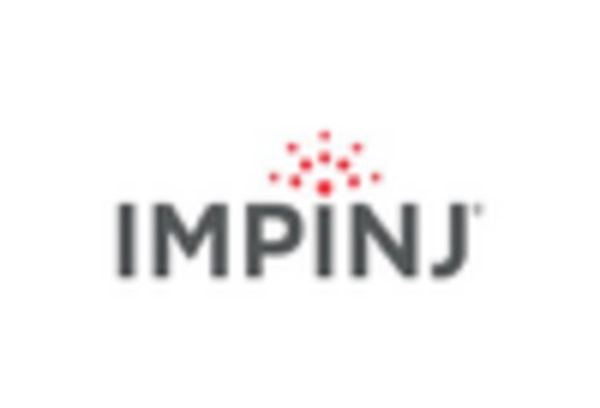Expansion of Smart City Initiatives
China's commitment to developing smart cities is a pivotal driver for the real time-locating-systems market. The government has allocated substantial funding towards urban modernization, which includes the implementation of advanced locating systems. As of 2025, it is estimated that investments in smart city projects will exceed $300 billion. These initiatives aim to improve urban management, transportation efficiency, and public safety. Real time-locating-systems play a crucial role in these developments by providing real-time data for traffic management, public transport tracking, and emergency response systems. The integration of these technologies is expected to enhance the quality of life for urban residents while simultaneously driving market growth.
Increased Focus on Safety and Security
The growing emphasis on safety and security in various sectors is propelling the real time-locating-systems market in China. Organizations are increasingly recognizing the importance of monitoring personnel and assets to mitigate risks. This trend is particularly evident in industries such as manufacturing and logistics, where safety regulations are stringent. The market for safety-related RTLS applications is projected to grow at a CAGR of approximately 10% over the next few years. Companies are investing in these systems to ensure compliance with safety standards and to enhance overall security measures. The ability to track individuals and assets in real-time not only improves safety but also fosters a culture of accountability within organizations.
Rising Adoption in Healthcare Facilities
The healthcare sector in China is increasingly adopting real time-locating-systems to improve patient care and operational efficiency. Hospitals are utilizing these systems for tracking medical equipment, staff, and patients, which enhances workflow and reduces wait times. The market for healthcare applications is anticipated to grow at a CAGR of around 12% through 2026. This growth is driven by the need for better resource management and the increasing complexity of healthcare operations. Real time-locating-systems enable healthcare providers to monitor the location of critical assets in real-time, thereby improving service delivery and patient outcomes. As the healthcare industry continues to evolve, the demand for these systems is likely to expand.
Growing Demand for Asset Tracking Solutions
The increasing need for efficient asset management is driving the real time-locating-systems market in China. Industries such as manufacturing, logistics, and retail are adopting these systems to enhance operational efficiency. According to recent estimates, the asset tracking segment is projected to grow at a CAGR of approximately 15% over the next five years. This growth is attributed to the rising costs associated with lost or misplaced assets, which can significantly impact profitability. Companies are investing in real time-locating-systems to minimize these losses and improve inventory accuracy. Furthermore, the integration of advanced technologies, such as RFID and GPS, is enhancing the capabilities of these systems, making them more appealing to businesses seeking to optimize their supply chains.
Technological Advancements in RTLS Solutions
Technological innovation is a key driver of the real time-locating-systems market in China. The development of more sophisticated locating technologies, such as ultra-wideband (UWB) and Bluetooth Low Energy (BLE), is enhancing the accuracy and reliability of these systems. As of 2025, the market for advanced RTLS technologies is expected to grow significantly, with projections indicating a potential increase of 20% in adoption rates. These advancements allow for improved tracking capabilities in various sectors, including retail, logistics, and healthcare. The ability to provide precise location data in real-time is becoming increasingly valuable for businesses aiming to streamline operations and enhance customer experiences.

















Leave a Comment